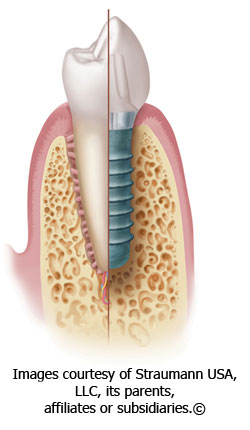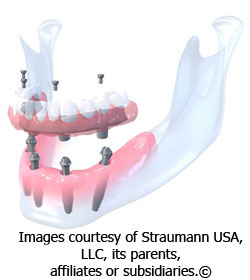A dental implant is an artificial tooth root that is placed into your jaw to hold a replacement tooth or bridge. Dental implants may be an option for people who have lost a tooth or teeth due to periodontal disease, an injury, or some other reason.
 How do dental implants work?
How do dental implants work?
Teeth restored with dental implants look, feel and function just like natural teeth. You brush, floss and visit your dentist for regular check-ups and cleanings, same as you would to care for a natural tooth.
After meeting with a periodontist in our office to develop your treatment plan, the placement of a dental implant usually involves several steps:
- The dental implant, usually a cylindrical and/or tapered post made of titanium, is placed surgically into the jawbone. It is most often a painless procedure, done with local anesthetic.
- As you heal, your implant will osseointegrate, or fuse with, your natural jawbone, with the two growing together to form a strong and long-lasting foundation for your replacement teeth. This healing process can take weeks to months while you proceed with your everyday life in between appointments.
- Once the implant bonds with the jawbone, a small connecting post – called an abutment – is placed on top of the dental implant to connect the implant to the replacement tooth or teeth.
- An individual tooth, an implant-supported bridge or dentures containing multiple teeth are then attached to the abutment.
SINGLE TOOTH DENTAL IMPLANTS
If you are missing a single tooth, one implant and a crown can replace it. A dental implant replaces both the lost natural tooth and its root.
Traditional replacement of a single tooth using a dental implant is often completed over multiple visits:
- Consultation and planning, including initial exam, imaging of your teeth, questions about your dental and medical history, and discussion of your treatment options.
- Placement of the dental implant, a substitute for the missing natural tooth root, either with or without a built-in abutment (a connector placed on, or built into, the top of the implant) that will attach to the replacement tooth. In some cases a temporary tooth can be placed while the dental implant integrates with your natural bone to form a strong foundation for your replacement tooth. Most people return to work the next day.
- Placement of the abutment, if one wasn’t placed during the prior visit.
- Placement of a custom-made crown, or replacement tooth.
What are the advantages of a single-tooth implant over a bridge?
A dental implant provides several advantages over other tooth replacement options. In addition to looking and functioning like a natural tooth, a dental implant replaces a single tooth without sacrificing the health of neighboring teeth. The other common treatment for the loss of a single tooth, a tooth-supported fixed bridge, requires that adjacent teeth be ground down to support the cemented bridge.
Because a dental implant will replace your tooth root, the bone is better preserved. With a bridge, some of the bone that previously surrounded the tooth begins to resorb (deteriorate). Dental implants integrate with your jawbone, helping to keep the bone healthy and intact.
In the long term, a single implant can be more esthetic and easier to keep clean than a bridge. Gums can recede around a bridge, leaving a visible defect when the metal base or collar of the bridge becomes exposed. Resorbed bone beneath the bridge can lead to an unattractive smile. And, the cement holding the bridge in place can wash out, allowing bacteria to decay the teeth that anchor the bridge. A dental implant will never decay because it is made of titanium.
Multiple Teeth Replacement with Dental Implants
Replacing multiple teeth using dental implants with individual crowns or with an implant-supported fixed bridge gives your teeth a level of fit, feel and functionality that is not possible with other treatment options. The process is often completed over multiple visits:
- Consultation and planning, including initial exam, imaging of your teeth, questions about your dental and medical history, and discussion of your treatment options.
- Placement of the dental implants that will be used to support your replacement teeth. Temporary teeth can be placed while the dental implant integrates with your natural bone to form a strong foundation for your replacement teeth. Most people return to work the next day, and any discomfort can typically be treated with commonly used pain medication.
- Placement of the abutments (connecting posts), or a small extension that will help connect your replacement teeth, on top of each implant, if needed.
- Placement of a fixed, implant-supported bridge, or custom-made replacement teeth (crowns).
 “Immediate Implants” or Immediate Restorations
“Immediate Implants” or Immediate Restorations
Immediate Restoration allows patients with missing teeth or dentures to get dental implants and natural-looking replacement teeth in just one office visit. You may have seen news stories or ads about Teeth-in-a-Day® or Teeth-in-an-Hour®, and thought they sounded too good to be true. These trademarked names, describing an accelerated surgical and restorative protocol, are more commonly called Immediate Restoration.
Immediate Restoration gives patients a new set of teeth that cannot slip, shift, or fall out, and it allows patients the freedom to eat, speak and smile with confidence.
Extensive planning is required, and approaches may vary for each patient; however, the following key elements are integral components of Immediate Restoration:
- CT scanning and 3-D imaging allow for extremely precise dental treatment planning; thus, ensuring implants are placed in exact locations and in areas of dense bone.
- Provisional tooth restorations are made before the patient’s appointment.
- In a single appointment, old dentures or failing teeth are removed, several implants are placed evenly around the jaw, and a connected arch of non-removable temporary teeth is attached to the implants.
- The provisional teeth restorations remain until osseointegration is complete. With this technique, implants remain stable because they are splinted together, and patients are thrilled that they can avoid a removable denture. Immediate Restoration can also be used for single implants when a CT scan shows that the patient’s bone is very dense. Permanent tooth restorations are placed once osseointegration is complete.
Am I a candidate for Dental Implants?
If you’re missing one or more teeth, probably so! Nearly anyone in good health whose jaw has finished growing is a candidate, whether they were simply born without a tooth or lost one or more teeth due to injury, decay, periodontal disease, infection or another reason.
Dental implants also are a great option for patients who don’t want the drawbacks of, or can no longer wear, removable dentures.
The best way to determine if you are a candidate is to see our periodontist!

